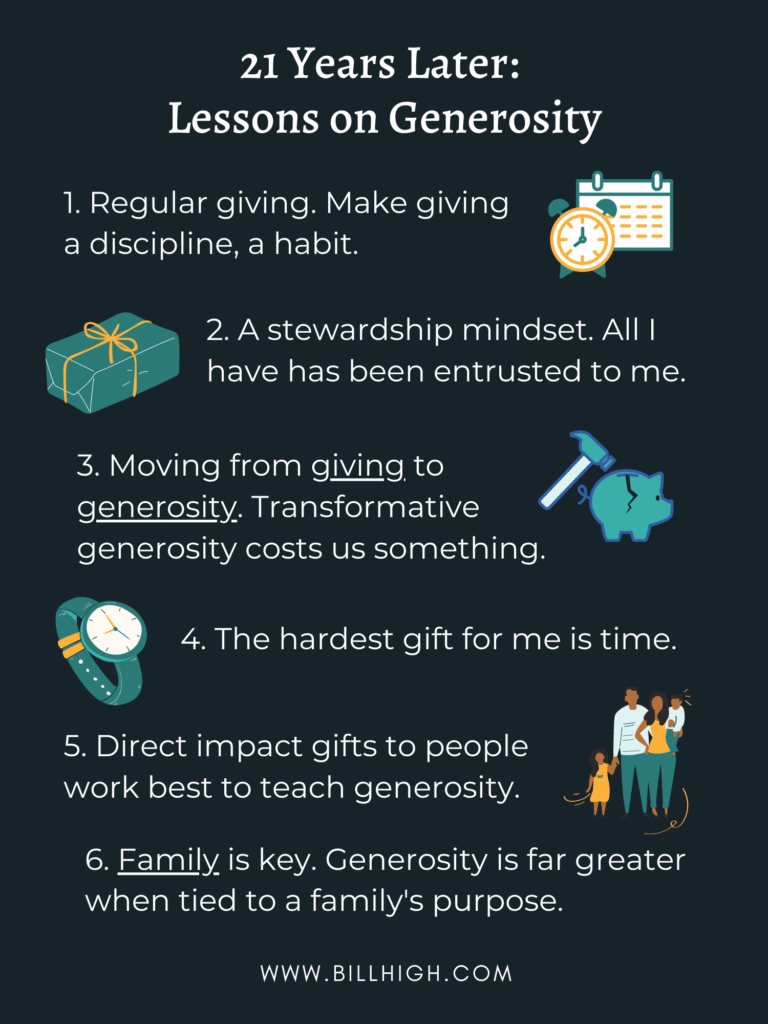21 Years!—6 Lessons on the Generosity Movement
I’m celebrating 21 years in the charitable giving world. When I started in June of 2000, we were on the front end of the generosity movement.
Why does the movement matter?
Simply, a generous life is a joyful life. A joyful life impacts the world we live in and those around us in the most profound way. In contrast, the stingy life is narrow and not big enough to let others in.
Twenty-one years in the generosity movement have yielded some great lessons. Some of those lessons are personal to me, of course.

Lesson One
The first key to growing generosity is systematic giving.
Regular giving—whether weekly or monthly—is key because when people become systematic in their giving, it reflects a discipline. It also reflects faith—faith that there are needs out there bigger than my own and faith that God will provide for me beyond this day. It is a truth of life that the occasional giver never gets to the place of being truly generous.
Lesson Two
I’m not the owner. I’m just a steward.
The second key to growing generosity is the fundamental truth that I’m not the owner. I’m just a steward, a manager. A stewardship mindset says that I’m a caretaker for others; I’m here to make things better for those around me and for those to come. An ownership mindset focuses on what I can receive. I’ve seen it time and time again that the transition to a stewardship mindset is one of the greatest keys to living a generous life.
Lesson Three
Moving from giving to generosity.
For many, giving is still a transactional idea. It represents the notion of what I’m supposed to do—whether for religious or civic duty. It’s obligatory. It’s often reflected in percentage giving. But for those moving from the transactional to the transformational our giving begins to no longer make sense. Craig Groeschel calls it irrational generosity. When our giving begins to impact our retirement plans, our financial plan, our college savings, our goals and objectives—when it simply doesn’t make sense—that’s when we begin to move into the realm of the generous.
Lesson Four
The hardest gift to make is time.
In our busy, busy world the hardest gift to make, certainly for me, is the gift of time. To be fully present, fully focused in the moment. The gift of time in the midst of career climbing, personal pursuits, and our noisy lives is perhaps the greatest gift we can make. The gift of time includes serving in the community, and it ultimately says that this moment—the right here and now—matters just as much as what might happen in the future.
Lesson Five
The most powerful gift to teach generosity—direct impact gifts.
Do you want to teach your children to be givers? Your grandchildren? The most powerful gift to make is the direct impact gift. Make a gift directly to an individual in need. Give the gift directly to the homeless person. Pay for the family’s adoption process. Gifts to institutions can be gifts without a face. Without a doubt when we associate real people with our gift and the impact we can make, it changes everything. I guarantee it.
Lesson Six
Family is the key.
I’m in the donor advised fund world and I’ve preached the message of generosity for a long time. And there’s little doubt that the idea of having a place (i.e., a donor advised fund) to do your giving is a powerful tool. In fact, I still encourage every family to create a fund as a way to start the conversation of giving within the family.
But there’s the key to great generosity—family. As we help families work together to build a common vision, mission and values, generosity is always the key to living out their values. And that generosity becomes far greater if it is tied to the purpose of the family.
This is just a quick summary of the lessons over the last 21 years. There are so many people, places and ideas that are tied to these lessons, I could write a book about them. But I’m interested in your lessons as well. Feel free to share them with me.
Share this Post
Published June 1, 2021
Topics: Generosity

